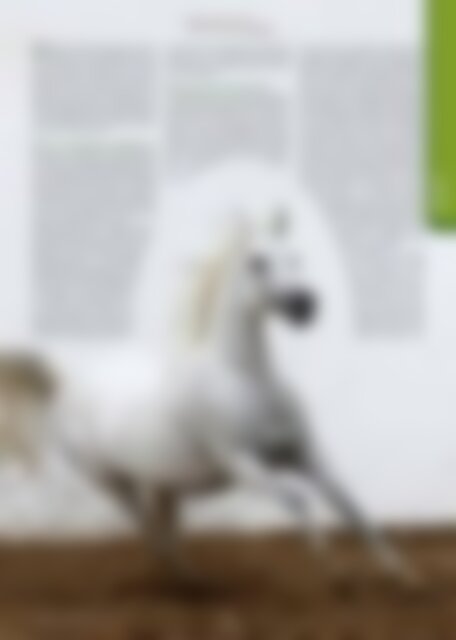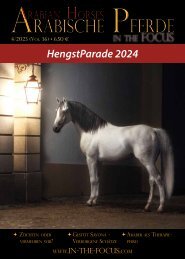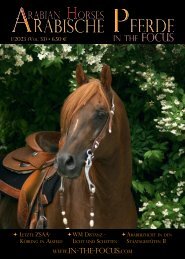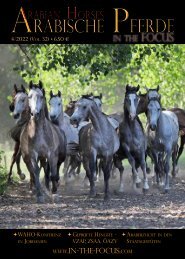Arabische Pferde IN THE FOCUS 4/2020 (Vol. 24) - public
Zeitschrift für Liebhaber und Züchter Arabischer Pferde
Zeitschrift für Liebhaber und Züchter Arabischer Pferde
Erfolgreiche ePaper selbst erstellen
Machen Sie aus Ihren PDF Publikationen ein blätterbares Flipbook mit unserer einzigartigen Google optimierten e-Paper Software.
The drive to Dashour alone was worth the<br />
trip! Here we met rural Egypt, which takes<br />
place on a narrow strip to the right<br />
and left of the Nile. Palm groves and small<br />
villages alternate, and the further we go into<br />
the country, the more often we come across<br />
donkey carts instead of cars. With every junction<br />
the road gets narrower until it becomes a<br />
dirt road, wedged between property walls on<br />
one side and the canal on the other - hopefully<br />
no car will come our way!<br />
Analytical Approach to Breeding<br />
We come to a large gate that opens in front of<br />
us and drive to the farm of Hammad Rabeii,<br />
the stud manager of Philippe Paraskevas, our<br />
host. Philippe Paraskevas has been breeding<br />
Arabian horses for over 30 years - and for 5-6<br />
horse generations. But unlike other breeders,<br />
it wasn't just their beauty that captured him,<br />
but their inner qualities, their nature, their<br />
character and their ability to work.<br />
Philippe Paraskevas has a slightly different<br />
and analytical approach to Arabian horse<br />
breeding. And so he studied the sire and<br />
dam lines of the RAS / EAO and Inshass<br />
breeding intensively – i.e. the foundation<br />
horses of the "pure Egyptians" - and<br />
has committed himself to maintaining<br />
these lines in their original appearance.<br />
In addition, he pays attention in<br />
his breeding to characteristics such<br />
as a will to please, character, health<br />
and fertility, but of course also<br />
ride-ability, because the Arab was<br />
a war horse. For Paraskevas, the ride-ability<br />
has the same priority as the other<br />
criteria, and so his horses, and especially<br />
the stallions, are regularly ridden for several<br />
hours in the desert.<br />
Different Selection Criteria<br />
It is interesting for the visitor that although<br />
the horses here all go back to the same foundation<br />
horses of the RAS / EAO / Inshass, as<br />
do the horses of the Egyptian State Stud El<br />
Zahraa or other private Egyptian breeders,<br />
they look somewhat different due to other<br />
selection criteria: They are usually of calibre,<br />
have strong hindquarters and correspondingly<br />
powerful, energetic<br />
movements,<br />
the neck may not always be perfect, but<br />
usually long enough and well arched, and<br />
they often - not always - have a straight profile<br />
with a beautiful, well-placed eye. Where<br />
there is a “dish”, it is more likely to be “accidental”,<br />
but not the product of targeted mating<br />
to achieve it. It is important to Paraskevas<br />
to preserve the individual characteristics<br />
of each of the strains and the associated dam<br />
lines. For example, he describes the Obeyans<br />
as balanced horses with high tail carriage,<br />
with large and expressive eyes, inspired by<br />
the spirit of the desert. The Kuhailan Krushs<br />
are rather reserved, proud and haughty, and<br />
they need time to develop a relationship with<br />
their rider. About the Kuhailan Krush mare<br />
El Kahila, especially when bred to El Deree,<br />
the "desert look" - this particular dryness<br />
of the structures - has been preserved.<br />
The Saklawi Jedranis, whose line goes<br />
through the legendary Moniet el Nefous,<br />
are characterized by balance<br />
and harmony, by elegance and<br />
delicacy, but sometimes they<br />
also have a long back.<br />
For Paraskevas, the Arab<br />
horse must not be pressed<br />
into a “template” - on the<br />
contrary, his motto is “diversity”.<br />
Diversity in shape<br />
(phenotype) and diversity<br />
in blood lines (genotype),<br />
because even<br />
the Arabian horse of the<br />
desert was by no means<br />
uniform! However, this<br />
Zucht<br />
4/<strong>2020</strong> - www.in-the-focus.com<br />
13
















